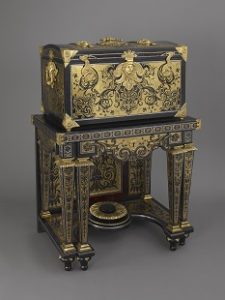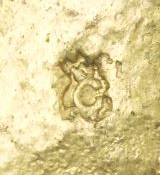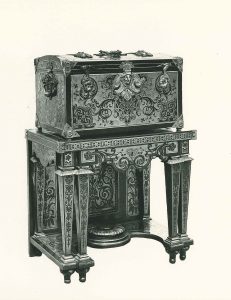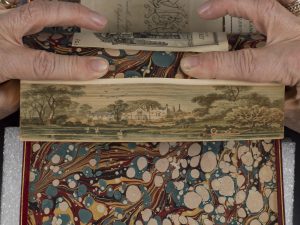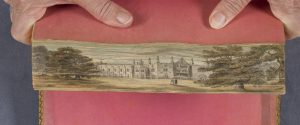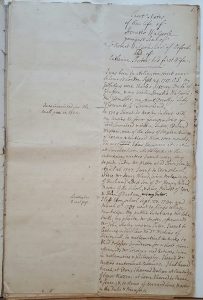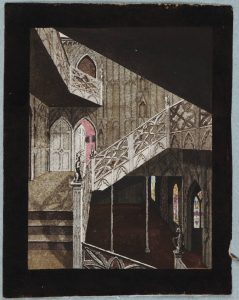Choice 3: Walpole’s Mezzotint of The Ladies Waldegrave
By Wilmarth S. Lewis
To begin his Choice 3 in Rescuing Horace Walpole, Lewis details Horace Walpole’s relationship with his brother Edward before turning his attention to Edward’s mistress and children.
“Edward had four children by his mistress, Dorothy Clement, who Horace said was ‘a milliner’s apprentice at Durham.’ The children were Laura, Maria, Edward, and Charlotte. They appear together in a most attractive conversation piece by Slaughter that is now in the Minneapolis Art Museum. When they were ill Uncle Horace took them to Strawberry Hill and looked after them, an instance of his ‘great disposition’ to Edward’s children. Laura married a Keppel who became Bishop of Exeter. Maria’s first husband was the second Earl Waldegrave; her second husband, whom she married secretly without her Uncle Horace’s approval, was George III’s younger brother, the Duke of Gloucester. Charlotte married the fifth Earl of Dysart. Walpole reported the death of the younger Edward to Horace Mann: ‘My brother has lost his son, and it is no misfortune, though he was but three and thirty, and had very good parts; but he was sunk into such a habit of drinking and gaming, that the first ruined his constitution, and the latter would have ruined his father.’
“Maria, the beauty of the family, was her Uncle Horace’s favorite. He boasted to Horace Mann of how he brought about her marriage to Lord Waldegrave who was twenty-one years her senior. ‘A month ago,’ Horace wrote, ‘I was told that he liked her. . . . I jumbled them together, and he has already proposed. For character and credit he is the first match in England–for beauty, I think she is. She has not a fault in her face or person, and the detail is charming. A warm complexion tending to brown, fine eyes, brown hair, fine teeth, and infinite wit, and vivacity. . . . My brother has luckily been tractable, and left the whole management to me.’ A pastel of her, very beautiful in her coronation robes, has appeared since I wrote this chapter. It hangs in the center of the new library at Farmington next to her father. Horace’s affectionate concern for Maria extended to her three Waldegrave daughters, Elizabeth Laura who married her cousin the fourth Earl Waldegrave, Charlotte Maria, Duchess of Grafton, and Anna Horatia, who married her cousin Lord Hugh Seymour Conway after the death of her first betrothed, the Duke of Ancaster. These three are ‘The Ladies Waldegrave’ of Reynolds’s conversation piece that shows them sewing at their work table. The original picture is now in the National Gallery of Scotland; Reynolds’s bill for it, 300 guineas, is at Farmington and so is Walpole’s copy of Valentine Green’s mezzotint of it, a proof before letters. It is what I have chosen to save from all the objects relating to Edward and his family at Farmington. Walpole pasted it into his copy of the 1784 Description of Strawberry Hill saved in Choice 9. That copy was acquired in 1919 for £1650 by Sabin and Co. of Bond Street. They removed the mezzotint of The Ladies Waldegrave and held it for 2000 guineas because they said it is ‘the finest English mezzotint in existence.’ The book itself came to Farmington in 1927 at a greatly reduced figure. During the next eleven years I would stop in at Sabin’s to pay my wistful respects to the print. Its price wilted during the Depression and I was not surprised when on the day war was declared my cabled offer of $500 was promptly accepted. The beautiful print sailed safely through the newly laid German mine fields to Farmington where it hangs beside drawings of Strawberry Hill that were formerly with it in the book. Drawings of Charlotte, Horatia, and Elizabeth Laura are also at Farmington along with a lock of the latter’s hair, braided, in a gold case.”
Lewis moves on to address the other members of the family and their portraits and correspondence now at the Library.
Lewis, Wilmarth S. Rescuing Horace Walpole. New Haven and London: Yale University Press, 1978.
To see the full chapter from Rescuing Horace Walpole called Choice 3: Walpole’s Mezzotint of The Ladies Waldegrave download or expand the link here:
 Loading...
Loading...
N.B. The identity of the woman in the pastel portrait Lewis describes above has since been reassigned. It is now thought to be a portrait of Maria Walpole (1725?-1801) illegitimate daughter of Sir Robert Walpole, prime minister and his mistress Maria Skerrett; the daughter later became the wife of Colonel Charles Churchill.

![[Lady Elizabeth Laura, Lady Charlotte Maria & Lady Anne Horatia, daughters to James late Earl of Waldegrave Knight of the Garter]](https://campuspress.yale.edu/walpole300/files/2017/08/lwlpr16495-q7mgs9-300x262.jpg)
